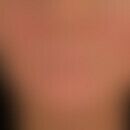Hierfür ist eine Anmeldung erforderlich. Bitte registrieren Sie sich bei uns oder melden Sie sich mit Ihren Zugangsdaten an.
Synonym(s)
Blue-white veil; milky way; whitish veil
DefinitionThis section has been translated automatically.
Reflected light microscopic phenomenon as a consequence of reactive compact hyperkeratosis of the stratum corneum, combined with epidermal hypergranulosis.
General informationThis section has been translated automatically.
Incident light microscopy: An opaque, milky glass-like veil is formed in the incident light microscopic projection plane. A bluish shimmer is produced by light reflection in the area of underlying melanophagus agglomerates (always without transepidermal pigment exudation) or the melanocyte nests (Tydall phenomenon). Accompanying neovascularizations convey reddish color effects.
OccurrenceThis section has been translated automatically.
Within the group of pigment cell tumors the characteristic of opaque appearing veil-like structures is found with a specificity of more than 95% in malignant melanomas (sensitivity about 30%). This phenomenon rarely occurs in Spitz nevi, blue nevi or recurrent nevi.
LiteratureThis section has been translated automatically.
- Bahmer FA, Fritsch P et al (1990) Terminology in surface microscopy. J Am Acad Dermatol 23: 1159-1162
- De Giorgi V (2003) Blue hue in the dermoscopy setting: homogeneous blue pigmentation, gray-blue area, and/or whitish blue veil? Dermatol Surgery 29: 965-967
- Kreusch J, Rassner G (1991) Reflected light microscopy of pigmented skin tumors. Thieme, Stuttgart New York
- Menzies SW, Crotty KH, Ingvar C, McCarthy WH (1996) An atlas of surface microscopy of pigmented skin lesions. McGraw-Hill, Sydney New York San Francisco
- Menzies SW (2001) A method for the diagnosis of primary cutaneous melanoma using surface microscopy. Dermatol Clin 19: 299-305
- Pizzichetta MA (2004) Amelanotic/hypomelanotic melanoma: clinical and dermoscopic features. Br J Dermatol 150: 1117-124
- Proud W, Braun-Falco O, Bilek P, Landthaler M, Burgdorf WHC, Cognetta AB (2002) Color atlas of dermatoscopy. Blackwell, Berlin Vienna





